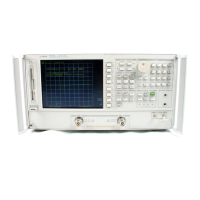42 Chapter 2
Quick Start: Learning How to Make Measurements
Learning to Make Reflection Measurements
Step 1. Choose measurement parameters with your test device
connected
NOTE For purposes of explanation, a 125 MHz bandpass filter was used as the
test device throughout this section.
1. Press the
Preset key to return the analyzer to a known state.
2. Connect your test device as shown in Figure 2-8.
CAUTION Damage may result to the device under test if it is sensitive to
analyzer's default output power level. To avoid damaging a sensitive
DUT, be sure to set the analyzer's output power to an appropriate level
before connecting the DUT to the analyzer.
Figure 2-8 Connections for Reflection Measurements
3. Choose the following measurement parameters:
Meas, Refl:FWD S11 (A/R)
Center, 125, M/µ
Span, 100, M/µ
Menu, POWER, 5, x1, RETURN
Scale Ref, AUTO SCALE
NOTE If you press Start and Stop, the analyzer will show the frequencies at the
beginning and end of the frequency span that you have set up around the
center frequency. This is also another method you could use to set the
analyzer's measurement frequencies.
4. Look at the device response to determine if these are the measurement parameters that
you want. For example, if the trace is noisy you may want to increase the input power,
reduce the IF bandwidth, or add averaging. Or, to better see an area of interest, you
may want to change the test frequencies.

